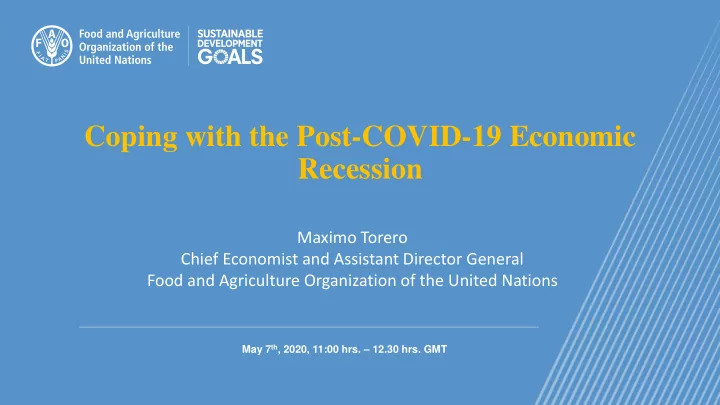

Coping with the Post-COVID-19 Economic Recession Maximo Torero Chief Economist and Assistant Director General Food and Agriculture Organization of the United Nations May 7 th , 2020, 11:00 hrs. – 12.30 hrs. GMT
First phase of COVID-19 Containment Food Systems Transformation
The basic channels of transmission 3 Logistics – health and lockdown 1 Macro policies 4 2 Health policies - lockdown 3 Trade policies 2 4 Economic recession 1 Source: Schmidhuber, Pound and Qiao, 2020. http://www.fao.org/3/ca8430en/ca8430en.pdf
Then and now: food exp xport restrictions durin ing two cris isis 30% 35 33 Number of countries aplying export 30 25% Share of Global Trade * 25 20% 10 restrictions 20 14 16 15% 15 10% 10 5% 5 0% 0 Covid-19[2020] FoodPriceCrisis[2008] As a share of global trade (calories)* Number of countries with export restrictions Note: * global trade is defined on non-intra EU trade flows, and for Source: Laborde (2020), IFPRI unprocessed food products and excluding sugar.
Second phase Consequences Food Systems Transformation
Real GDP Growth Annual percent change Source: IMF- Outlook
Cou Countr tries Req equiring Ex Extern rnal Assistance for or Foo ood in n Afri rica March 2020 Data source: FAO GIEWS Disclaimer: The designations employed and the presentation of material in the maps do not imply the expression of any opinion whatsoever on the part of FAO concerning the legal or constitutional status of any country, territory or sea area, or concerning the delimitation of frontiers.
Highest Valued Exports
Top African agricultural imports and exports
What to do? Health-food- development trilogy Food Systems Transformation
What to do? Meet immediate needs of vulnerable populations: Urgent increases in food availability from smallholder farmer food production Food Systems Transformation
Disclaimer: The designations employed and the presentation of material in the maps do not imply the expression of any opinion whatsoever on the part of FAO concerning the legal or constitutional status of any country, territory or sea area, or concerning the delimitation of frontiers.
What to do? Meet immediate needs of vulnerable populations: Issues on trade and tax policies Adjustments to trade and tax policies Improve ef fi ciency Encourage better functioning Immediately review trade and Avoid generalized subsidies Reduce restrictions on food markets through improved taxation policy options for food consumers use of stocks of trade facilitation regional political and economic and their likely impacts integration and better functioning for trade in food Use limited strategic Minimize use of export Reduce import tariffs and Temporarily reduce grain reserves restrictions other restrictions VAT and other taxes Food Systems Transformation
Why intra-Africa trade matters? Achieving economies of scale and exploiting comparative advantages • Income growth and reaching minimal size to develop industries Trade integration among “similar” countries could generate a lot of benefits • e.g. European Union • Reduced institutional differences or gaps in standards (e.g. SPS). • Generate a lot of intra-sectoral trade leading to reduced adjustment costs Regional value chains are important to favor integration in global value chains • Example ASEAN • Developing regional markets is not aimed to replace global integration, just to do the right choices at the right scale Risk pooling strategy • Integrated markets are more resilient to risk: e.g. weather shocks, locusts etc. • Price stabilization
Intraregional trade of agricultural products Intra Africa trade represents 20% of the continent agricultural trade Dollars Calories Share of African exports going to Africa 21.8% 42.0% Share of African imports from Africa 16.4% 9.2% African integration of agricultural products has significantly improved over the last 20 years, and is not lagging specially behind the other continents.
Intra-Africa trade has increased but remains limited. Still, it is more intensive in processed food with additional value added. Source: Laborde and al. (2019, AATM report)
Potential large gains for the AfCFTA Real Income: +$20bn Real Income: (per year, 2024 or +0.81% +$6bn welfare) (per year, 2024 or +0.25% welfare) AfCFTA with tariff AfCFTA with tariff elimination elimination, trade facilitation and FDI Source: Laborde and Fousseini (2019)
Africa Continental Free Trade Area (AfCFTA): Level of customs duties on intraregional imports and on all imports
Africa Continental Free Trade Area (AfCFTA): Quality of infrastructure 2018
Africa Continental Free Trade Area (AfCFTA): Costly Non-tariff Measures (NTMs) Share of NTMs faced by Share of NTMs faced by Kenya Tanzania Source: Bouet and Odjo, Africa Agriculture Trade Monitor 2019
THANK YOU Food Systems Transformation
Recommend
More recommend